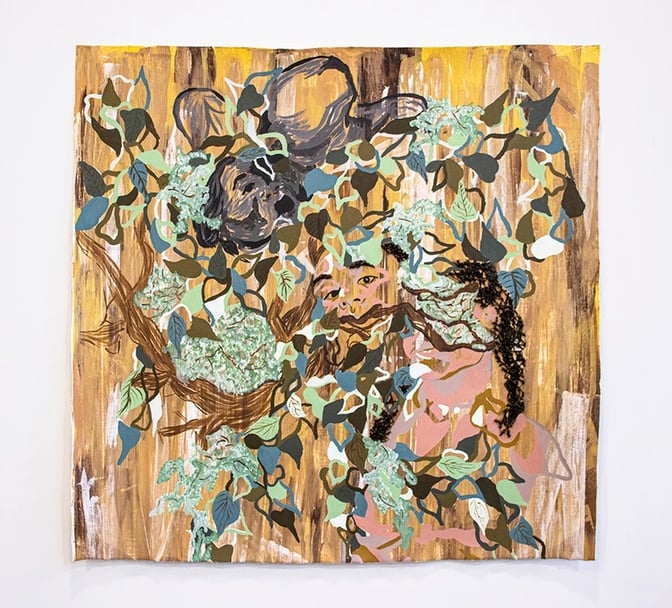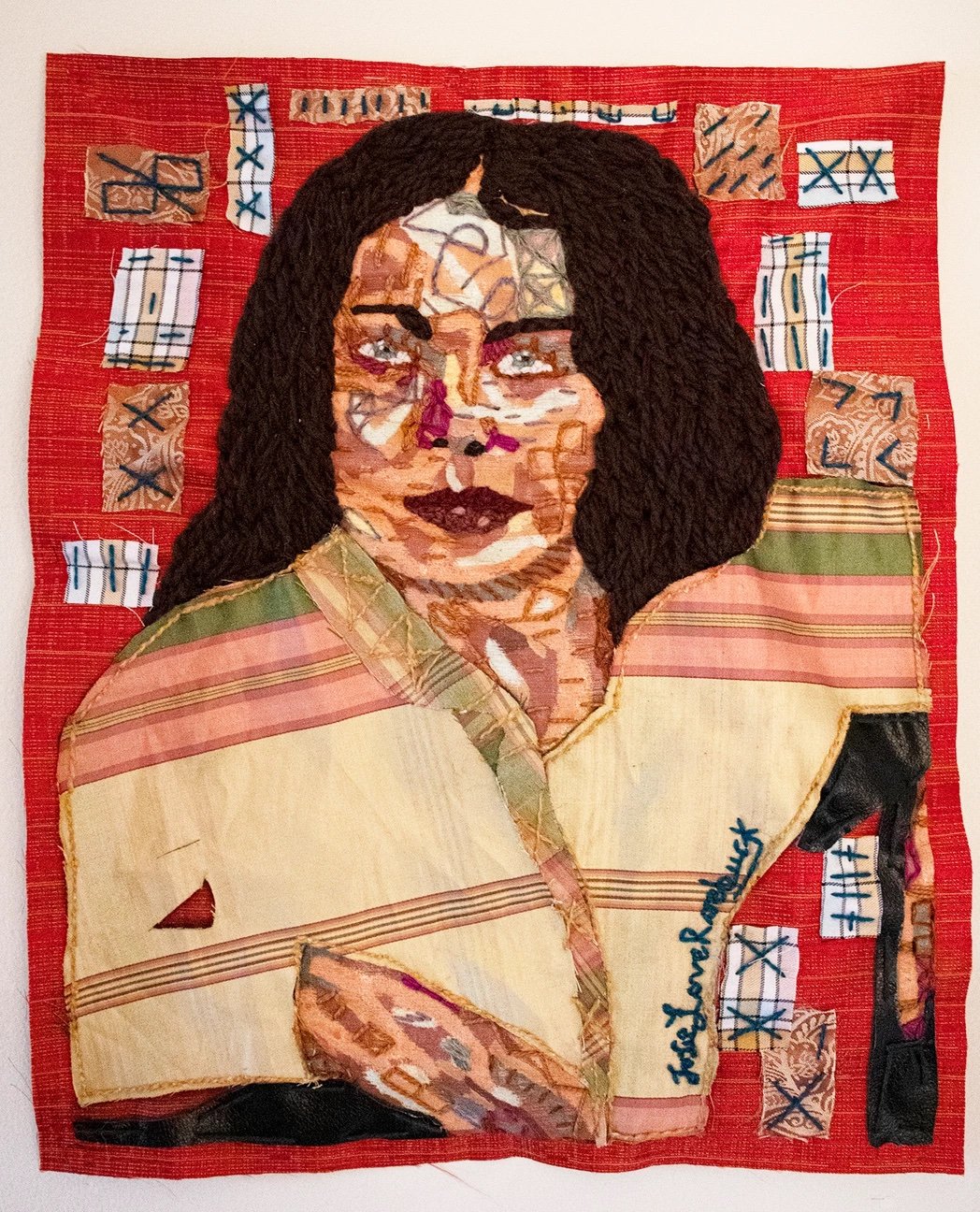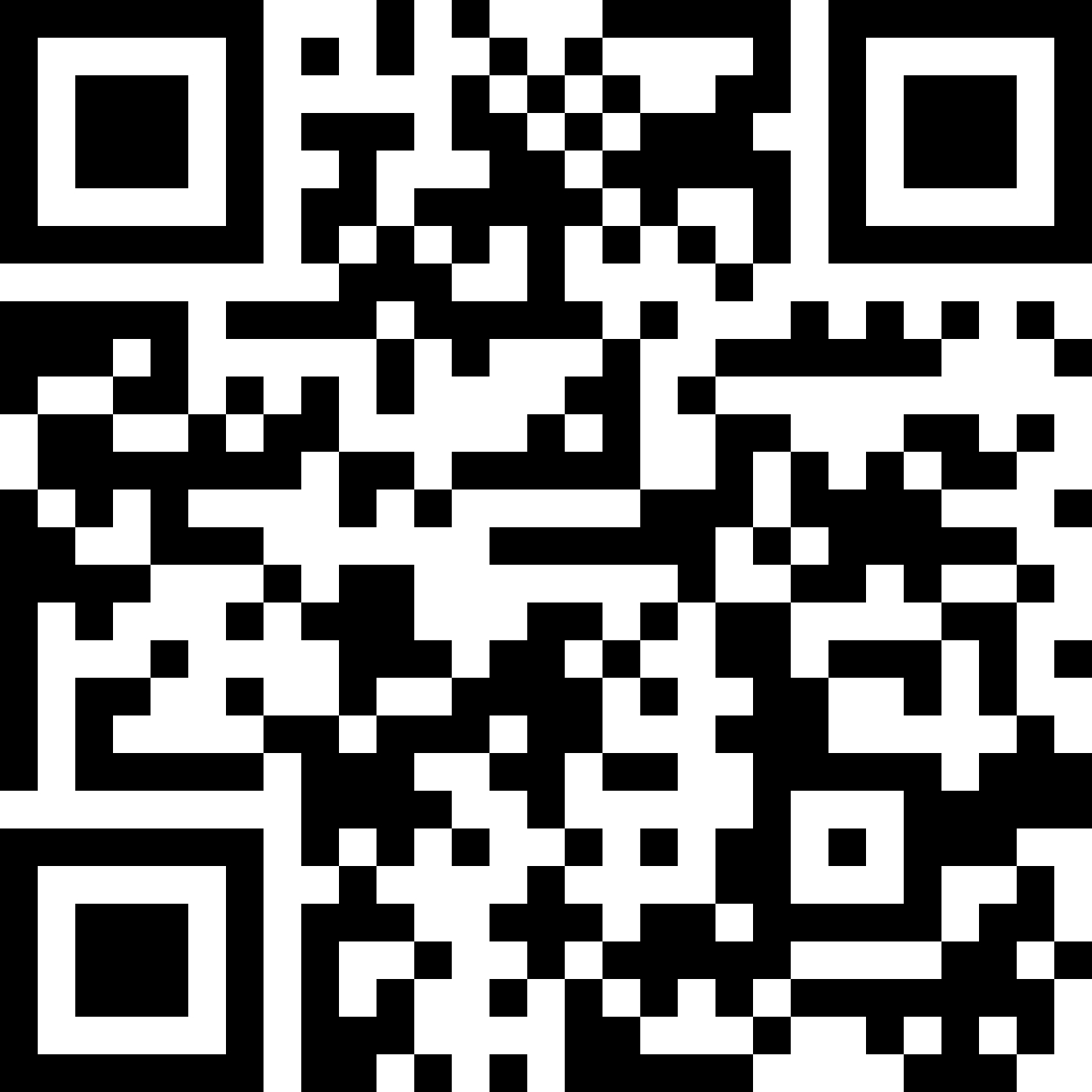Josie Love Roebuck on the power of healing through art
Bronwyn Hunter-Shortly on August 12, 2022
As we approach the launch of Peggy, we’re thrilled to give everyone a sneak peek into some of the Pegcasts that will be live on the app.
Bronwyn Hunter-Shortly, VP of Art at Peggy, chatted with Josie Love Roebuck and learned about how she uses her art to share the stories of sexual assault survivors. Josie Love Roebuck is represented by LatchKey gallery and lives and works in Cincinnati.
 Josie Love Roebuck. Credit Josie Love Roebuck via josielroebuck.net
Josie Love Roebuck. Credit Josie Love Roebuck via josielroebuck.net
Bronwyn Hunter-Shortly: Thanks for being with me here today, Josie, I'm excited to chat with you about your practice. Let's start with why you make art.
Josie Love Roebuck: There are so many reasons. I've been doing it for as long as I can remember. A lot of my childhood is blocked from me and so parts of it, my mom has shared with me. When I was younger, I took a folk art class and I learned how to do quilts and stuff like that. I was always invested in sewing. But the main reason I'm doing [art making] is to help others share what true experiences can look like.
We can all learn from each other and grow from there and change history that way. Art has also saved me. I'm a survivor of sexual assault. So me talking about that work has allowed me to grow as a person and heal.
I also want to give that portion back to my audience. We're all healing together, whether we have different stories or different experiences. It's about coming together and bringing about this community where we can all learn from each other. And it's helped me figure out my way in life. I am 25 years old. I just graduated from the University of Cincinnati and I've been in school my whole life. So I've been trying to figure out where I stand. There's a lot of political unjust. Art has allowed me to tackle subject matters that I'm passionate about, something that I can share my voice about things that are often ignored so that it can really shed light on the problematic things that are happening in America.
It comes down to really sharing what it's like to be a human being, what people go through and how we can all grow and heal.
BHS: It's so powerful that you're using art to share your story. I'm sure there are many viewers who look at it and have similar stories and really admire and respect your sharing. And I think that's one of the reasons I love art because you can bring your own history to it.
JLB: Thank you. I've done two different subject matters. I've tackled the emotional destruction of sexual assault, it's all my face, but it's other peoples’ stories. It's stories that others have shared with me. But they haven’t been ready to share their faces. I've gotten to a place in my life where I'm very open about my own experiences and what I've faced. So I'm comfortable allowing my face to be that spokesperson, but it's not always just my experience. I want to connect with others and hear what has happened to them and what they wish they had learned through that healing process.
It’s about combining my own personal story as this fibre with my other friends, or strangers that have opened up to me by viewing my work. Just sharing all these aspects and different ways of coping and how we heal.

“The Repetition of Traumatic Memory”, 2020. Acrylic, india ink, and yarn on unstretched canvas. Credit Josie Love Roebuck via josielroebuck.net
BHS: I noticed a couple of different things in your works. I noticed the use of camouflage a lot, and I wonder is that a big part of your messaging?
JLB: Oh, absolutely. A year ago that was a big part of my work. I was really questioning what a city space was and what that could look like for a survivor. Taking interior settings or just other things that are familiar and are supposed to be safe. I also wanted to camouflage my victims to really emphasize that we want to identify as being almost normal with no one judging us or looking at us a certain way. A part of it is about blending in with your surroundings and what that can be like for a survivor. Not always wanting to open up and share your stories or be judged or looked at differently. So it's about either not fully being ready to be seen or how society has ignored what has happened to you and how we need to step out of these shadows to be able to be comfortable to share these experiences so that others can learn.
BHS: That's so powerful. You were saying that you've worked in a couple different mediums. Will you tell us about the different mediums? You also do a lot of portraits now, have you always been super interested in portraits?
JLB: To be honest, two years ago, I was absolutely afraid to do portraits. I had some professors at undergrad that were kind of judgemental about the way I drew or painted and that took away that confidence for me, always hearing their voices whenever I would draw a face. Then I got to a point in my practice where I realized I needed to change that perspective. Through the message I was trying to share I needed to give my survivors a face to really emphasize that we need to listen and hear what has happened. A lot of times, as a survivor, you remember your perpetrator's face, but we don't remember the survivor's face or their story. And so I wanted to change that perspective so we could remember the survivors and what they went through. That played a big role in why I got the courage to make portraiture again and it’s become an important aspect of my practice.
Now with my new body of work, touching on the complexity of identifying as biracial, I've wanted to still do portraiture, but also kind of get away from that. But I realize in trying to do that, I am not happy. Creating these faces and compositions is about sharing these experiences and telling these stories. So I can't really get away from it because that's a major part in how I'm piecing together these figures with different materials and how that makes up who we are.
I've had other people say, oh, ‘portraiture is dead, you need to focus on trying to do other things.’ I can't, it's something I love and it's something worth expressing because as human beings, we hold so much in our facial features and it tells where we've been and what we've experienced. So it's a huge aspect in my own practice.
As for my materials, I use screen printing, charcoal, pastel, yarn, and occasionally acrylic paint will come into play. But to me, the use of material is very important, just like using a portrait. It symbolizes how we have so many things that make us who we are. There's no straight line to one individual and it's just kind of this messy, chaotic experience. And by using these materials, I can really emphasize that and piece together all of these different identities, stories and experiences. Whether the experiences are happy and joyful or traumatic ones, I can emphasize that we're messy human beings, which is wonderful and fine.
In my opinion, you can't just use one material to really emphasize the magnitude of a human being and how we have so many factors that go into who we are.
 “Untitled 1980”, 2021. Screenprint ink, fabric, oil pastel, and yarn. Credit Josie Love Roebuck via josielroebuck.net
“Untitled 1980”, 2021. Screenprint ink, fabric, oil pastel, and yarn. Credit Josie Love Roebuck via josielroebuck.net
BHS: So many layers there, conceptually and in the material. And I love that you put both of those together. How important is it to you for your viewers to know the full picture? Do you have a message that you want them to come away with?
JLB: It depends on what message I'm trying to present. Sometimes with my work, I am very direct, so my viewers will get all the facts upfront and then sometimes they're more obscured.
There's always important messages throughout my work. In my body of work that I'm tackling now, the complexity of identifying as biracial, I have multiple stories. A lot of it is about the prejudice that I have faced or other people of color have faced, but it also touches on a beautiful aspect of being a person of color.
There are always these dull meanings that happen throughout my pieces. The message that I theoretically and really want to share is that we all need to wake up. We all need to realize what the past has looked like, what our present looks like and how we can use that to change history, change it for the better where these prejudices can go away. We don't have to judge a person by their facial features, how they speak or how they act, because that doesn't determine who they are. I need to wake up, even myself as a person of color, I need to wake up, really listen to other people's experiences so I can learn from them and be better because of what they've gone through. So I don’t bring about what has happened to them again.
That kind of goes into play with the scale of my work as well. Sometimes I use small intimate portraits, which is more to confront the viewer, so they can contemplate what I'm trying to say and really sit with it.
And then other times I have really large scale work and that's more about shouting my message to really shake someone and say listen up, this is not okay. It's also about overwhelming the viewers so they can get different messages at different scales and understand what is happening in this world and how it needs to change.

“Magnificently Willful”, 2020. Screen-print, acrylic, yarn, braided yarn, pompoms, charcoal, oil pastel, ribbon, and fabric on canvas. Credit Josie Love Roebuck via josielroebuck.net
Sometimes my viewers won't grasp what I'm trying to say, but I write poetry that often accompanies my pieces. For example, I have a hair piece that is titled “Magnificently Willful”, and so that piece and that poetry is about sharing my shame of not wanting authentic hair, naturally curly hair. How society has tempted me and made me want to change it so that I can fit in. In the end it celebrates who I am and what my hair is, and how it doesn't need to be changed.
I write poetry to really explain fully, this is what this piece is about. Or there could be hidden messages within my work where I’ve taken some of that poetry and embroidered it onto the pieces or used oil pastel to give a clue about the message in a more direct way.
